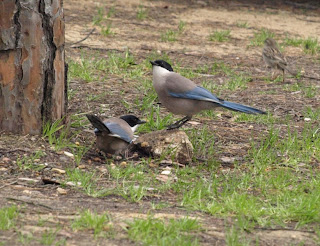As we journeyed north we had to negotiate Madrid. We decided to leave a visit to the centre till another time and went round the amazing system of motorway rings that seem to keep the traffic flowing smoothly. After a night at Riaza we took a slight detour into a village called El Burgo which we thought might be interesting and realised that we were just a short drive from the Cañón del Rio Lobos which turned out to be a magical place. Driving up the narrow road into the canyon we had no trouble parking in one of several large parking areas (this is a very popular spot with the Spanish during holiday periods). From there we walked, alongside the stream to a chapel – the Ermita de San Bartolome ...
... surrounded by strange rock formations ...
... through one of which we could see the canyon beyond. (You can see this gap just above and to the left of the centre of the previous picture). Birds of prey circled above us and when we drove back down the canyon and then zig sagged up the hairpin bends to a view point, we were more or less on a level with them.
The most majestic were the Griffon Vultures.
Palm Sunday found us in the delightful city of Pamplona, famous for its annual bull run through the narrow streets to the bull ring. We were able to watch a much more sedate Palm Sunday procession to the Cathedral, less “over the top” than the one we saw last year in Cadiz.
A suitably dressed children’s group with a very enthusiastic leader sang “Hosanna, Hosanna” ahead of a figure of Christ carried by a large group of men and at least one woman.
Pamplona seemed, on a Sunday at least, to be very much a “lived-in” city. The plazas were places to meet and relax with family and friends and in at least two of them there were interesting activities taking place – Country Dancing ...
... and a display by a local consumer group of organic food (with free samples!) Although there was a lot of open space and parkland the city was quite compact and in only a few minutes’ drive we were out in the countryside at our next site.
The journey over the foothills of the Pyrenees was less dramatic than last year’s expedition over one of the highest passes but we passed through beautiful forests of beech and then fir trees before saying adios to España and bonjour to La France. We had two nights on a lovely, quiet farm site before heading for Bordeaux where we are spending Easter as there is an Anglican church here.
On Easter Day we joined hundreds of other Christians from several different denominations and from many countries at 7.00 am for a Sunrise Service, held in the local park, led by Catholic, Orthodox, Anglican and Free Church Clergy supported by a Liturgical Dance group.
It was followed by breakfast and Communion in the school chapel used by the Anglican congregation here.
Tomorrow we continue the journey north.






























